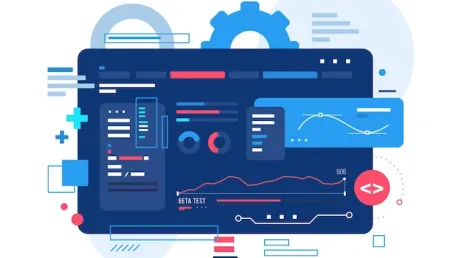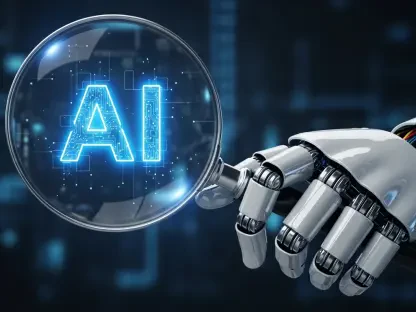The rapid evolution of artificial intelligence is transforming integrated development environments (IDEs), taking them from basic coding tools to sophisticated, intelligent development assistants. This advancement is revolutionizing workflows, optimizing tasks, and boosting productivity for developers across the globe. By supercharging traditional IDE capabilities, AI empowers developers to focus on solving complex problems and fostering innovation, rather than getting bogged down with routine tasks.
Traditional IDE Features
Before the integration of AI, IDEs played a crucial role in enhancing developers’ productivity by consolidating various essential tools into a single platform. These foundational tools enabled developers to work smarter and faster, setting the stage for the capabilities seen in today’s intelligent IDEs.
One of the earliest productivity boosters within traditional IDEs was syntax highlighting and code formatting. By using distinct colors to differentiate keywords, variables, functions, and other elements within the code, syntax highlighting made reading and writing code more manageable. This visual differentiation helped developers quickly understand code structure, spot typographical errors, and reduce mistakes. When paired with automatic code formatting, which ensured consistent indentation and styling, these features contributed to maintaining clean, readable code, especially in large projects with multiple contributors.
Another integral feature of traditional IDEs was the streamlined process of writing, compiling, and executing code. Early IDEs allowed developers to integrate these steps into a single workflow, enabling them to write their code, compile it, and instantly see the results. By offering a rapid feedback loop for iterations and experimentation, these tools reduced the time required to test new ideas or fix bugs.
Integrated debuggers revolutionized the debugging process, offering features such as breakpoints, step-through execution, and variable inspection. These tools provided deeper insights into the runtime behavior of code, enabling faster and more efficient diagnoses and resolutions of issues. This advancement allowed developers to deliver more reliable software in less time.
For navigating extensive codebases, early IDEs introduced powerful search and navigation tools. Features like “go to definition” and “find all references” helped developers understand the interactions within their codebase, saving hours of manual searching. These tools were particularly valuable in large projects, where locating specific variables, methods, or files was a significant challenge.
Code templates and snippets also played a vital role in reducing repetitive coding tasks. Predefined chunks of code could be quickly inserted into a project, whether it was a boilerplate class definition, a common function, or a frequently used design pattern. These templates enabled developers to adhere to coding standards with reduced effort and maintained consistency across projects.
The rise of collaborative development made version control integration essential. Early IDEs incorporated tools like Git and SVN, allowing developers to commit, branch, and merge code directly within the IDE. This integration improved collaboration and minimized the friction of switching between different tools for development and version control.
Extensibility through plugin ecosystems was another valuable feature of traditional IDEs. Developers could customize their environments by adding tools tailored to specific languages, frameworks, or workflows. This flexibility made IDEs more adaptable and allowed them to remain relevant as development practices evolved. These early features paved the way for modern AI-powered capabilities, transforming time-consuming tasks into streamlined processes and boosting productivity.
AI-Powered Features of Intelligent IDEs
With AI at the helm, modern intelligent IDEs redefine traditional editing and compiling by automating repetitive tasks, streamlining workflows, and empowering developers to work more efficiently. These tools enhance the development process by providing advanced capabilities that go beyond basic functionality.
AI-driven code explanation capabilities are particularly remarkable, as they help developers understand unfamiliar or legacy code. By analyzing blocks of code and providing plain-language summaries, these tools describe what the code does without requiring developers to decipher each line. This feature is invaluable when working with large codebases, saving hours of effort and enhancing team collaboration. For instance, developers can highlight a section of legacy code and instantly receive an explanation, including the logic and intent behind the code. This capability extends to debugging and refactoring tasks as well.
Intelligent code completion tools take traditional code completion a step further by understanding the broader context of a project. These AI-powered tools analyze tasks, coding styles, and application architecture to suggest improved code, complete functions, or structural changes. This contextual awareness enables developers to write code more quickly and accurately, promoting consistency within development teams regardless of varying experience levels. Increased development speed, simpler maintenance, and reduced errors are the ultimate outcomes of this enhanced code completion.
Proactive debugging assistance elevates the debugging experience by meticulously analyzing error messages, identifying potential pitfalls, and highlighting issues within the code. These tools offer insightful suggestions for fixes, enabling developers to diagnose and resolve problems before clicking “Run.” Efficient debugging not only accelerates the development process but also improves the overall quality of software.
Automated documentation features significantly ease the burden of writing extensive documentation. Intelligent IDEs can generate comments, inline explanations, and complete API documentation based on the code, ensuring projects remain well-documented with minimal effort. This automation is crucial in collaborative settings where clear documentation is essential for effective teamwork. By generating a baseline automatically, developers can focus on enhancing documentation to include edge cases and nuanced details.
Unit tests are another area where AI-powered IDEs excel. These tools analyze code to generate test cases automatically, significantly improving code quality by encouraging thorough testing coverage. Automated tests allow developers to refine and expand test cases to address more complex scenarios, ensuring robust and reliable software.
AI-driven refactoring tools are indispensable for maintaining clean and efficient code. These tools analyze the entire codebase to offer suggestions for improving structure and readability. They can identify redundant code, propose optimizations, and recommend alternative implementations while preserving existing functionality. For example, an AI-powered IDE might suggest consolidating repetitive code patterns into reusable functions or dividing excessively long methods into smaller, manageable parts. By automating tedious aspects of refactoring, developers can focus on strategic improvements, resulting in cleaner and more performant code.
Intelligent Code Completion and Debugging
The true power of intelligent code completion lies in its ability to understand the broader context of the project. Unlike traditional tools that merely suggest the next word, AI-powered IDEs delve deeper into the coding style, architecture, and the specific tasks at hand. This advanced understanding allows the tools to offer enhanced code suggestions, complete functions, and even propose structural changes. Such contextual awareness leads to faster coding, improved accuracy, and consistency across development teams, ultimately speeding up the entire development process.
In addition to code completion, intelligent IDEs offer proactive debugging assistance. Traditional debugging often involves a laborious process of identifying errors through error messages and manual code inspection. However, AI-driven tools elevate the experience by thoroughly analyzing error messages, identifying potential pitfalls, and highlighting problematic code sections. More than just pinpointing issues, these tools provide insightful suggestions and solutions, enabling developers to address challenges efficiently before even running the code. This advanced debugging capability not only saves time but also enhances the overall reliability of the software being developed.
Automated documentation further streamlines the development process. Traditionally, documentation requires extensive manual effort, but intelligent IDEs significantly ease this burden. By generating comments, inline explanations, and complete API documentation based on the code, these tools ensure that projects are well-documented with minimal effort. This automation is particularly valuable in collaborative settings where clear documentation is essential for effective teamwork. Developers can then focus on enhancing and expanding the documentation instead of starting from scratch, making the project easily understandable and maintainable.
Moreover, intelligent IDEs excel in testing automation. These tools analyze the code and automatically generate unit tests, encouraging thorough testing coverage. Automated tests not only improve code quality but also allow developers to refine and expand test cases, addressing more complex use scenarios. This automation ensures a robust testing framework, resulting in well-tested and reliable software.
Automated Documentation and Testing
The automation of documentation and testing is a significant advantage offered by AI-powered IDEs. Documentation, often seen as a tedious task, is streamlined through intelligent tools that can automatically generate comments, inline explanations, and complete API documentation based on the code written. This feature ensures that projects remain well-documented with minimal effort from developers, who can then focus on more critical aspects of development.
Automated documentation is invaluable in collaborative settings where clear and concise documentation is essential for effective teamwork. For instance, an AI-powered IDE can automatically generate a comment block summarizing the functionality, inputs, and outputs of a method. This baseline documentation makes it easier for team members to understand the code and contribute effectively. Developers can then enhance the automatically generated documentation to include edge cases and nuanced details, ensuring comprehensive project documentation.
Intelligent IDEs also revolutionize the testing process by automating the creation of unit tests. These tools analyze the code and generate test cases, encouraging thorough testing coverage that improves code quality. Automated tests allow developers to refine and expand test cases to address more complex scenarios, ensuring a robust testing framework. For example, an AI-powered IDE might analyze a newly written function and automatically create unit tests to verify its correctness, handling various input cases and edge conditions. This automation reduces the effort required to write tests manually and ensures consistent testing practices across the development team.
By automating documentation and testing tasks, AI-powered IDEs significantly reduce the time and effort developers need to invest in these essential but often time-consuming activities. This allows developers to focus on strategic improvements and innovation, ultimately leading to higher-quality software and more efficient development processes.
Enhanced Refactoring and Seamless Workflows
Refactoring is an essential practice for maintaining clean, efficient code, but it can be labor-intensive and error-prone. AI-powered IDEs enhance the refactoring process by analyzing the entire codebase and offering suggestions for improving code structure and readability. These tools can identify redundant code, propose optimizations, and recommend alternative implementations while preserving code functionality.
For example, an AI-powered IDE might identify repetitive code patterns across multiple files and suggest consolidating them into a reusable function. If a method is excessively long, the tool might recommend dividing it into smaller, more manageable parts. The true strength of AI-driven refactoring lies in its scalability; regardless of the complexity of the codebase, intelligent IDEs deliver actionable suggestions that save developers time and reduce the risk of introducing errors during refactoring.
AI-powered IDEs also excel in integrating seamlessly into developer workflows. Built-in features such as debugging insights, documentation generation, and automated testing eliminate the need to juggle multiple plugins or external tools, streamlining development processes and enhancing productivity. Developers can focus on coding and problem-solving instead of managing their development environment, leading to faster and more efficient development cycles.
IDEs such as Apple’s Xcode, JetBrains’ Rider, and Microsoft’s Visual Studio epitomize the transformation brought by AI. These platforms integrate AI-driven features to streamline development workflows, predict bottlenecks, and recommend best practices tailored to team workflows. As the software world continues to accelerate, AI-powered IDEs will play a pivotal role in driving innovation and productivity.
By automating routine tasks, enhancing productivity, and enabling developers to focus on creative problem-solving, intelligent IDEs represent the exciting future of software development. These tools reshape the way developers work, collaborate, and innovate, ultimately leading to the delivery of higher-quality software.
Conclusion
The rapid evolution of artificial intelligence is drastically transforming integrated development environments (IDEs). No longer just basic coding tools, present-day IDEs have become sophisticated, intelligent development assistants. This transformation is truly revolutionizing workflows, optimizing tasks, and ultimately boosting productivity for developers worldwide.
Thanks to AI integration, traditional IDE capabilities are being supercharged, offering developers the means to concentrate on solving complex problems and driving innovation rather than being bogged down by monotonous and routine tasks. This enhancement allows for improved code quality, quicker problem-solving, and more efficient project management. The intelligent automation of coding processes means that developers can now leverage AI to perform code reviews, detect bugs, and even generate code, significantly reducing the time and effort involved in manual coding.
Moreover, AI-enhanced IDEs provide features such as predictive coding, real-time error detection, and personalized recommendations, making the development process smoother and more intuitive. This not only enhances the overall development experience but also enables developers to stay ahead in a constantly evolving technological landscape. In essence, the infusion of AI into IDEs is a game-changer, driving a new era of innovation and efficiency in software development.









